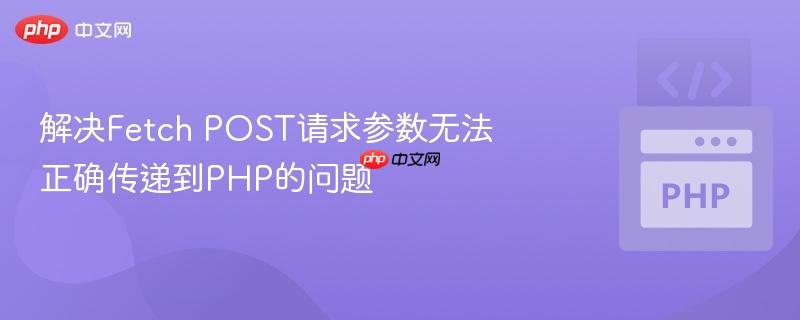
在使用javascript的fetch api向php后端发送post请求时,开发者常会遇到php的$_post数组为空的情况。这通常是由以下两个主要原因造成的:
当Content-Type不是application/x-www-form-urlencoded时,PHP默认不会填充$_POST全局变量。例如,如果Content-Type被设置为application/text,PHP会将其视为原始文本,需要通过php://input流手动读取。
为了确保fetch POST请求能够正确地将参数传递给PHP,我们需要从请求头和请求体两方面进行修正和优化。
确保fetch选项对象中的headers键只出现一次,并且Content-Type被正确设置为application/x-www-form-urlencoded。
错误示例:
立即学习“PHP免费学习笔记(深入)”;
let respuesta = fetch(fichero, {
method: "POST",
headers: { // 第一次出现 headers
'Content-Type': 'application/x-www-form-urlencoded',
},
body: '...',
headers: {"Content-type": "application/text; charset=UTF-8"} // 第二次出现 headers,会覆盖第一次
})在上述代码中,headers键出现了两次,JavaScript会采用后面的值,导致实际发送的Content-Type是application/text; charset=UTF-8,而不是application/x-www-form-urlencoded。
正确修正后的请求头:
let respuesta = fetch(fichero, {
method: "POST",
headers: {
'Content-Type': 'application/x-www-form-urlencoded', // 确保只设置一次且正确
},
body: '...', // 请求体部分将在下文详细说明
})请求体需要将表单数据以key=value&key2=value2的形式组织起来,并且每个值都必须进行URL编码。以下是几种推荐的方法:
这种方法适用于参数较少或需要精细控制参数名称和值的情况。你需要手动将每个变量的值进行encodeURIComponent编码,然后通过模板字符串拼接成符合application/x-www-form-urlencoded格式的字符串。
示例代码:
const fichero = "/proves/php/accion_formulario.php";
let tp_curso = document.getElementById("actualizar_nombre").value;
let vr_curso = document.getElementById("version_lenguaje").value;
let pr_curso = document.getElementById("programa_curso").value;
let fp_curso = document.getElementById("ficheros_curso").value;
let vp_curso = document.getElementById("videos_curso").value;
let n_curso_actualizar = "curso_actualizar_value"; // 假设这是另一个值
let respuesta = fetch(fichero, {
method: "POST",
headers: {
'Content-Type': 'application/x-www-form-urlencoded',
},
body: `nom=${encodeURIComponent(tp_curso)}&versio=${encodeURIComponent(vr_curso)}&programa=${encodeURIComponent(pr_curso)}&fitxers=${encodeURIComponent(fp_curso)}&videos=${encodeURIComponent(vp_curso)}&ncurs=${encodeURIComponent(n_curso_actualizar)}`,
})
.then(response => response.text())
.then(data => {
alert(data);
})
.catch(error => alert("Se ha producido un error: " + error));注意事项:
URLSearchParams接口提供了一种处理URL查询字符串的便捷方式。它可以接收一个对象作为构造函数的参数,自动构建并URL编码键值对。这是处理application/x-www-form-urlencoded类型请求体的推荐方法之一。
示例代码:
const fichero = "/proves/php/accion_formulario.php";
let tp_curso = document.getElementById("actualizar_nombre").value;
let vr_curso = document.getElementById("version_lenguaje").value;
let pr_curso = document.getElementById("programa_curso").value;
let fp_curso = document.getElementById("ficheros_curso").value;
let vp_curso = document.getElementById("videos_curso").value;
let n_curso_actualizar = "curso_actualizar_value";
const params = new URLSearchParams({
nom: tp_curso,
versio: vr_curso,
programa: pr_curso,
fitxers: fp_curso,
videos: vp_curso,
ncurs: n_curso_actualizar
});
let respuesta = fetch(fichero, {
method: "POST",
headers: {
'Content-Type': 'application/x-www-form-urlencoded',
},
body: params.toString(), // URLSearchParams对象会自动转换为适合body的字符串
})
.then(response => response.text())
.then(data => {
alert(data);
})
.catch(error => alert("Se ha producido un error: " + error));注意事项:
FormData接口提供了一种构建一组键/值对的方式,这些键/值对以与multipart/form-data请求相同的方式进行编码。虽然通常用于文件上传,但它也非常适合发送普通的表单数据,特别是当你的数据来源于一个HTML <form>元素时。使用FormData时,你无需手动设置Content-Type头,fetch会自动为你设置正确的multipart/form-data类型,并包含边界(boundary)。
示例代码(假设有一个ID为accion_form的表单):
<!-- HTML 示例 -->
<form id="accion_form">
<input type="text" id="actualizar_nombre" name="nom" value="前端课程">
<input type="text" id="version_lenguaje" name="versio" value="ES2023">
<input type="text" id="programa_curso" name="programa" value="JavaScript">
<input type="text" id="ficheros_curso" name="fitxers" value="docs">
<input type="text" id="videos_curso" name="videos" value="tutorials">
<input type="hidden" name="ncurs" value="curso_actualizar_value">
<button type="button" onclick="submitForm()">提交</button>
</form>// JavaScript 示例
const fichero = "/proves/php/accion_formulario.php";
function submitForm() {
const formElement = document.getElementById('accion_form');
const formData = new FormData(formElement); // 从表单元素直接创建FormData对象
// 如果需要添加不在表单中的额外参数,可以使用append方法
// formData.append('extra_param', 'extra_value');
let respuesta = fetch(fichero, {
method: "POST",
body: formData, // 直接将FormData对象作为body
// 注意:使用FormData时,不需要手动设置Content-Type,fetch会自动处理
})
.then(response => response.text())
.then(data => {
alert(data);
})
.catch(error => alert("Se ha producido un error: " + error));
}注意事项:
一旦前端fetch请求的参数和头部配置正确,PHP后端就可以通过$_POST全局变量轻松访问这些数据。
<?php
class CursoManager {
public $n_curso;
public $titulo_curso;
public $version_curso;
public $programa_curso;
public $dir_ficheros_curso;
public $dir_videos_curso;
public $params = [];
public function __construct() {
// 检查请求方法是否为POST
if ($_SERVER['REQUEST_METHOD'] === 'POST') {
// 确保$_POST中有数据
if (!empty($_POST)) {
$this->n_curso = $_POST["nom"] ?? null;
$this->titulo_curso = $_POST["versio"] ?? null;
$this->version_curso = $_POST["programa"] ?? null;
$this->programa_curso = $_POST["fitxers"] ?? null;
$this->dir_ficheros_curso = $_POST["videos"] ?? null;
$this->dir_videos_curso = $_POST["ncurs"] ?? null;
$this->params[0] = $this->n_curso;
$this->params[1] = $this->titulo_curso;
$this->params[2] = $this->version_curso;
$this->params[3] = $this->programa_curso;
$this->params[4] = $this->dir_ficheros_curso;
$this->params[5] = $this->dir_videos_curso;
} else {
// 如果$_POST为空,可能是Content-Type不匹配,或者body为空
// 可以在这里添加日志或错误处理
$this->params[] = "Error: No POST data received.";
}
} else {
$this->params[] = "Error: Invalid request method.";
}
}
public function displayParams() {
// 设置响应头,明确告知客户端返回的是纯文本或JSON
header('Content-Type: text/plain; charset=utf-8');
print_r($this->params);
}
}
$manager = new CursoManager();
$manager->displayParams();
?>注意事项:
正确地使用fetch API发送POST请求到PHP后端需要关注两个关键点:确保请求头中的Content-Type设置正确且无冲突,以及动态且正确地构建请求体。对于application/x-www-form-urlencoded类型的数据,推荐使用URLSearchParams或模板字符串结合encodeURIComponent。如果数据来源于HTML表单,FormData对象是更简洁高效的选择,它还能自动处理Content-Type。遵循这些最佳实践,可以有效解决fetch POST请求参数无法正确传递到PHP的问题,实现前后端数据的顺畅交互。
以上就是解决Fetch POST请求参数无法正确传递到PHP的问题的详细内容,更多请关注php中文网其它相关文章!

PHP怎么学习?PHP怎么入门?PHP在哪学?PHP怎么学才快?不用担心,这里为大家提供了PHP速学教程(入门到精通),有需要的小伙伴保存下载就能学习啦!

Copyright 2014-2025 https://www.php.cn/ All Rights Reserved | php.cn | 湘ICP备2023035733号